Thu 18 Mar 2010
A Movie Review by David L. Vineyard: ACROSS THE PACIFIC (1942).
Posted by Steve under Reviews , Suspense & espionage films[10] Comments
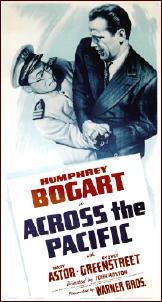
ACROSS THE PACIFIC. Warner Brothers, 1942. Humphrey Bogart, Mary Astor, Sidney Greenstreet, Victor Sen Yung, Keye Luke, Charles Halton, Richard Loo, Monte Blue. Screenplay by Richard Macauley, based on a Saturday Evening Post serial “Aloha Means Goodbye” by Robert Carson. Directed by John Huston .
Mary Astor: Well if anyone heard you complaining about it they would put you in a psychopathic ward.
It was inevitable that any follow up to The Maltese Falcon was going to be anti-climactic, which is a shame, because this lighthearted flag-waver has a myriad of charms all its own including the sexual byplay between Bogart and Mary Astor, and Sidney Greenstreet’s treacherous Dr. Lorenz.
And it probably didn’t help that midway through production the Second World War broke out with the very much for real attack on Pearl Harbor, and the plot about a fictional Japanese attack at the same location was suddenly too serious for this lighthearted treatment.
The production took a hiatus while the script was quickly rewritten, and somehow in the transition the title remained unchanged, even though now the ship in question never even reaches the Pacific. (It might also explain some less competent model work than usually seen from the studio effects department.)
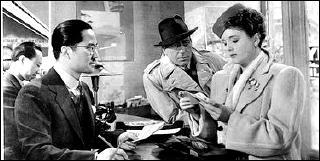
Bogart is Rick Leland, a US Army officer cashiered for irregularities with company funds. He heads for Canada hoping to enlist, but they want no part of him, so he determines to sell his services to the Chinese and sets sail on a Japanese ship sailing for Panama and then Yokohama.
On board the ship are Dr. Lorenz (who teaches economics in Manila), his servant, and Alberta Marlowe (Mary Astor)
who claims to be a simple girl from Medicine Hat out to see the world despite a wardrobe to die for and the sophistication of a woman of the world.
And as you quickly learn, nothing is exactly what it seems. Lorenz managed to get Leland on the ship because he knows of his military background, and Leland is in reality a secret agent, his disgrace a cover designed to lure Lorenz and the Japanese into approaching him.
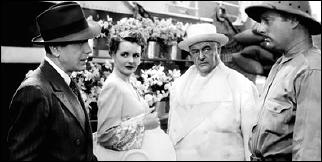
After a stop over in New York where Victor Sen Yung comes on board as a jive-talking Japanese American sailing East to take over family business interest, Leland and Astor stop a Filipino from assassinating Lorenz.
Mary Astor: I think I got pushed in the face by someone. My – My lipstick’s smeared.
Humphrey Bogart: Aww, you look cute.
Mary Astor: And now, if you’ll excuse me, I’ll go to my cabin… and faint.
the good doctor makes it clear he wants information from Leland about Panama’s defenses and is willing to pay for it while Leland romances Miss Marlowe
Humphrey Bogart: You stick around with me and you’ll get plenty of practice.
and ingratiates himself with Lorenz.
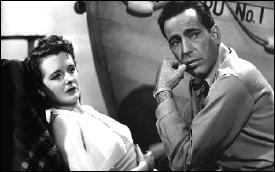
Once in Panama, things move fast. Astor disappears, and Greenstreet outwits Leland and gets the plans for the Canal’s air defenses. Leland meets a Chinese at a Japanese theater in Panama where a well staged shootout ensues, and then heads for a plantation that has been mentioned as a place of interest.
There he finds Astor, the daughter of the westerner (Monte Blue) forced to front for the Japanese, and discovers a hidden airfield built in the jungle. It’s December 6th, 1941, and using the information gotten from Leland, the Japanese are going to bomb the Canal to coincide with the attack on Pearl Harbor.
Of course they are no match for our hero, who dispatches Victor Sen Yung with a right cross and grabs Richard Loo’s .50 caliber machine gun to shoot down the bomber and take care of the rest.
Back at the plantation Sidney Greenstreet contemplates hari-kiri, but lacks the nerve and Leland arrests him.
And as they step outside a formation of American planes flies over:
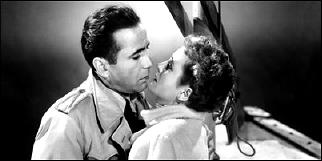
No one is arguing that this is the same category as The Maltese Falcon, but it is a remarkably assured and entertaining spy film with dialogue that sparkles and real sexual tension between Bogart and Astor.
This often gets lost among the bigger (and better) films of Bogart and Huston, but deserves to be seen and enjoyed. It’s fast, flip, sexy, and well acted by all concerned.
Maybe we should just be grateful that there are so many great films that this terrific good film gets lost in the shuffle. This tongue-in-cheek thriller is still fresh and smart, and more modern than most similar films of the era.
Note: Huston left to join the war effort and the final scene was shot by Vincent Sherman. And for some reason the two maps showing the Canal in the film are wrong. The one at the end of the film upside down with the Pacific on Panama’s East Coast! I suppose it’s possible the intent was to keep the enemy from using the maps, but you have to imagine the Japanese knew where the Canal was. You wouldn’t think it would be that easy to disguise.
March 18th, 2010 at 3:55 pm
David — I’ve watched ACROSS THE PACIFIC many times, and I always suspected there was something wrong with the closing sequence. Now I know: upside down maps!
Regardless, the film is a lot of fun for all the reasons you give, and surprisingly coherent considering the rewrites.
March 18th, 2010 at 4:51 pm
I’ve always liked ACROSS THE PACIFIC and have seen it many times. You can’t go wrong with John Huston directing Bogart and Sydney Greenstreet.
March 18th, 2010 at 10:59 pm
Mary Astor, too!
I have the feeling, though, that MALTESE FALCON and this movie were the high points of her career, which I never realized until now, when I looked her up, continued on to 1964 (HUSH HUSH SWEET CHARLOTTE).
She was also in DESERT FURY, a pretty good Noir film that was a rarity, filmed in color.
But oops, speaking of high points, I see I missed one completely. Mary Astor won an Oscar (Supporting Actress) for THE GREAT LIE (1941), with Bette Davis and George Brent in the lead roles.
I’ve never seen that movie, and maybe I should.
— Steve
March 18th, 2010 at 11:56 pm
Astor’s impressive resume includes RED DUST, THE KENNEL MURDER CASE, THE CASE OF THE HOWLING DOG, THE HURRICANE, MEET ME IN ST. LOUIS, THE PRISONER OF ZENDA, MIDNIGHT, PALM BEACH STORY, and DODSWORTH.
Today it’s THE MALTESE FALCON she’s known for, but her roles in THE PRISONER OF ZENDA and MEET ME IN ST. LOUIS are equally iconic, if not quite the same league.
For my money her best role is the sane European woman American millionaire Walter Huston falls for rather than his snooty unfaithful wife (Ruth Chatterton) in the fine adaptation of Sinclair Lewis DODSWORTH. THE GREAT LIE is worth seeing, but basically a soap while DODSWORTH is one of the best film adaptations of a novel ever done with Astor and Huston well matched. Aside from Huston and Chatterton the cast includes Paul Lukas, David Niven, and the debut of John Payne. She’s damn sexy in it too.
Her role in RED DUST was played by Grace Kelly in the remake MOGAMBO, her role in ZENDA by Jane Greer, and her role in THE HURRICANE by Mia Farrow.
She also shows a fine hand at screwball comedy in Preston Sturges PALM BEACH STORY as Rudy Valee’s much married sister who falls for Claudette Colbert’s ex Joel McCrea.
THE GREAT LIE is the one where Brent marries Bette Davis after his marriage to Astor (his true love) is annulled. His plane is lost and pregnant widow Davis and Astor battle each other and the elements when they are stranded together. You can guess what the ‘great lie’ proves to be.
March 18th, 2010 at 11:58 pm
While the part is not challenging, I’d argue that the best FILM Astor ever appeared in is “Meet Me In St. Louis”. She’s better in “THe Maltese Falcon”, though.
I also prefer “Red Dust” to “Across The Pacific”, but believe me: that’s no knock on “Across The Pacific”. I just particularly enjoy how the Jean Harlow character treats Astor’s character in that one.
March 19th, 2010 at 6:14 am
ACROSS is lightweight, fun and forgettable; FALCON stays in the memory.
Mary Astor said in her autobiography (between getting laid) that she was upset at the way she was treated by MGM; a couple years after playing romantic leads at Warners they relegated her to “mother” parts.
March 19th, 2010 at 7:24 pm
David,
You’ve got it backward about “The Great Lie”
Davis was Brents’ true love and Astor was the pregnant one whom Davis paid to carry the pregnancy to full term, so she could have her “presumed dead” lovers child.
Steve,
This is one of my favorite Bette Davis movies, and you should put this on your wish list from Amazon (or whichever)!!
Great performances all around. And Tchaikovsky to boot!
March 19th, 2010 at 7:59 pm
Paul
Thanks. Been years since I saw THE GREAT LIE. I hope I didn’t leave the impression it was less than a terrific movie, I just don’t think it is in the same class as DODSWORTH which is a better film and a better performance by Astor. As you say though, the score is magnificent.
For some reason this one isn’t shown as often as some of Davis other films of this era.
Calling it a soap isn’t a knock though. NOW VOYAGER is soap opera too. Some of Bette’s best work is in soap opera.
But I still hold Astor is better in DODSWORTH or even RED DUST, PALM BEACH STORY, and MEET ME IN ST. LOUIS. It wouldn’t be the first time a well deserved Oscar was won for the wrong movie by the right performer.
November 21st, 2011 at 12:36 am
I don’t understand how the errors in this film’s ending have been overlooked. The character Joe is a Karate expert, but Joe is knocked unconscious to the floor in a sucker punch. When he shoots the drunken, staggering, weakened and old father to Mary Astor’s character, he takes three shots. Thus giving hero Bogie enough time to leap up, wrestle the gun away and knock out Joe. Joe is no opposition to Joe. AND although Joe has been featured in scene after scene as a smart American born, jitterbug talking, hipster, he has no death scene. We don’t see him come out of his unconscious state, after Bogie’s fist fight for the gun. We see Mary Astor recover from her knocked out state to join Bogie on the airstrip, but Joe remains in the house. We never see him again. He must have hit his head and died on that floor from minor injuries. We don’t see a resolution to his nasty and treasonous acts. What a mess.
June 14th, 2020 at 11:05 pm
David, whether Ator is good, bad or indifferent in any of the films you’ve mentioned, she is not the leading lady in any of them. I don’t much care for her work, although she has an effective scene with Gable in Any Number Can Play, and as for her work in The Maltese Falcon, her persona not performance, is the least interesting in a powerhouse cast. Across The Pacific seems to have been manufactured for Falcon’s audience. In any case, I didn’t like it much.